There are more than one hundred different cannabinoids in hemp. But, in recent years, CBD has attracted a disproportionate amount of attention. It’s true that the recognition and popularity of CBD is deserved, but this shouldn’t distract from the fact that there are dozens of other potentially even more interesting cannabinoids within the hemp plant. In this post, we’ll provide an overview of seven other extremely promising cannabinoids.
The Cannabinoid Family Tree
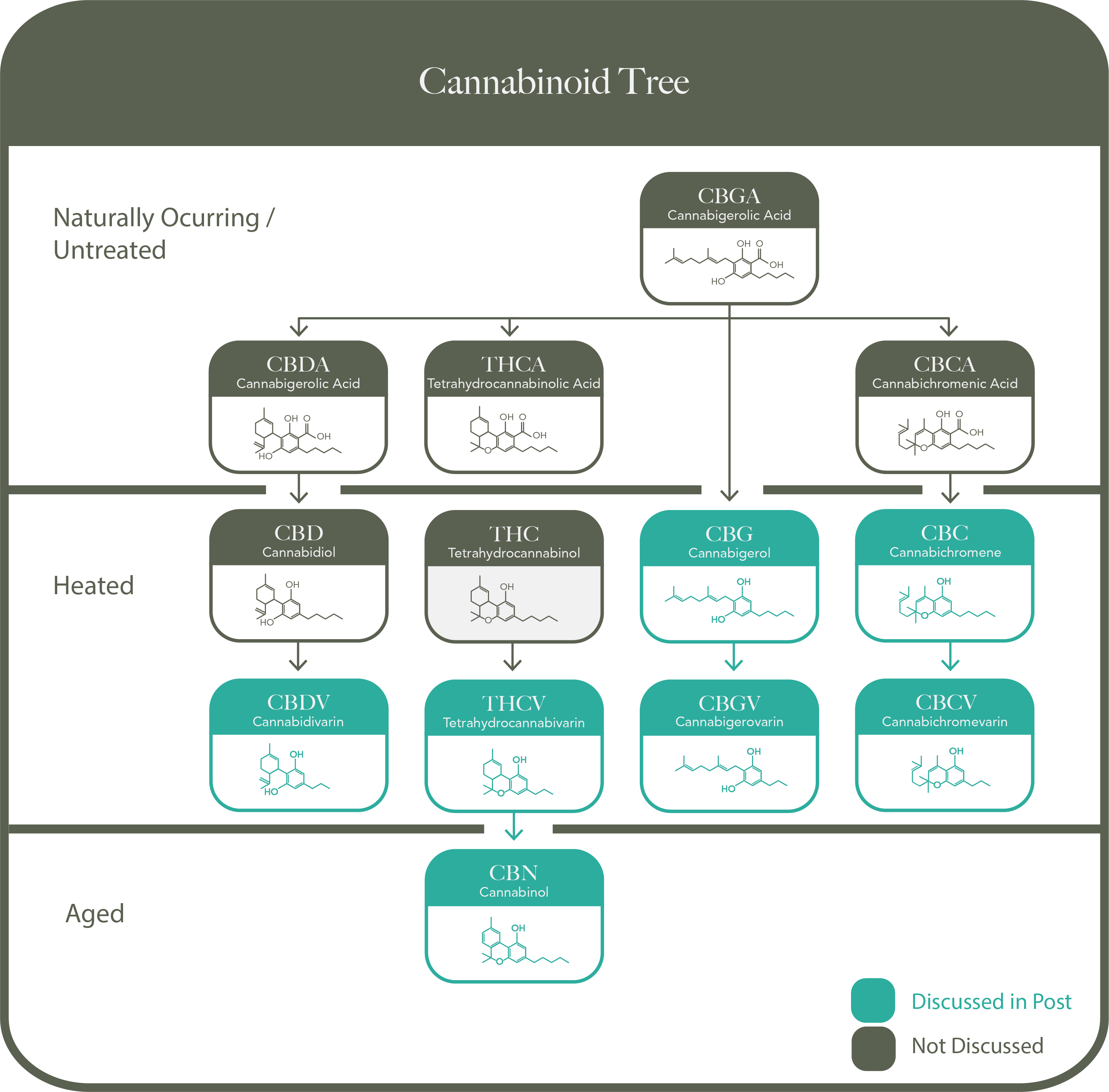
In order to understand how these different cannabinoids relate to each other, it’s helpful to understand the cannabinoid family tree. Cannabinoid synthesis begins with CBGA (Cannabigerolic Acid), so you can think of CBGA as the head of the family tree.(1)
After CBGA has been made, hemp plants can then naturally synthesize three more cannabinoids: CBDA (Cannabinolic Acid), THCA (Tetrahydrocannabinolic Acid), and CBCA (Cannabichromenic Acid). The ‘A’ suffix on each of these signifies that these are acids.(2)
The next generation of cannabinoids includes CBD, THC, and CBC. As these names suggest, these are simply the non-acidic versions of the predominant cannabinoid acids. CBD, for example, is almost structurally identical to CBDA. The only difference between these is that CBDA has an extra carboxyl group which makes it an acid, while CBD does not have this carboxyl group.(3)
Cannabinoids can be decarboxylated through heat or time. Decarboxylation is sometimes referred to as “activation” because scientists previously believed that cannabinoid acids were biologically inactive. However, recent studies have disproved this belief, and we now know that cannabinoid acids do have biological benefits. For this reason, we like to think of decarboxylation as “transformation” instead of “activation.” CBDA and CBD, for example, are both active compounds, they simply do different things.(4)
The final generation of cannabinoids includes CBGV (Cannabigeroverin), CBCV (Cannabichromeravin), CBDV (Cannabidivarin), and THCV (Tetrahydrocannabivarin). The ‘V’ ending on each of these cannabinoids signifies that they are chemically shortened. CBDV, for example, looks like a CBD molecule that is missing two methyl bridges. Biochemistry aside, the big thing to note about the ‘V’ class of cannabinoids is that while they are structurally similar to their precursors they also produce different biological effects.(5)
Understanding Cannabinoids
Every generation and vertical line of cannabinoids comes with a unique set of traits and biological effects. Because of this, different people will be most interested in different cannabinoids, or different combinations of cannabinoids. However, until recently consumers have been constrained by the biological variability of hemp plants.
Breakthroughs in cannabinoid science now allow cutting-edge producers to synthesize and isolate specific cannabinoids, including CBG, CBGV, CBC, CBCV, CBDV, THCV, and CBN. In the wild, hemp plants will naturally contain less than 1% of these minor cannabinoids. However, only a few of today’s top labs have pioneered how to isolate these cannabinoids. With these cannabinoids now available, it is time for us to consider the benefits of each. Here’s what we know about each of these cannabinoids:
CBG (Cannabigerol)
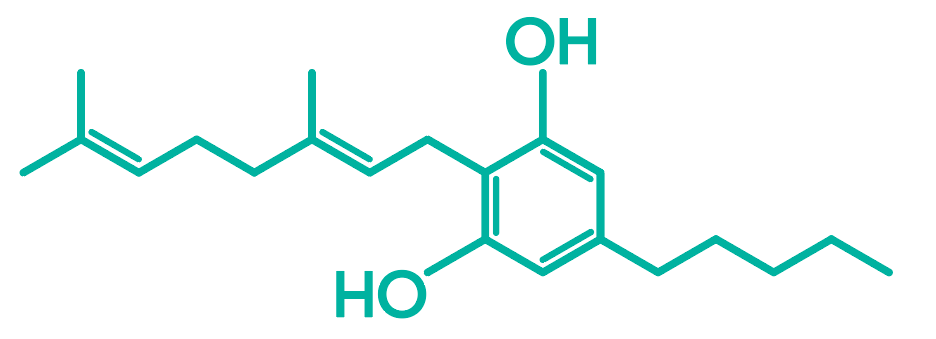


CBG is a non-psychotropic cannabinoid that shows promise in treating many different medical conditions. A 2018 study found that CBG exerted a protective action in an in vitro neuroinflammation model. This means that CBG may reduce oxidation and inflammation in brain cells. The scientists behind this study now “encourage the use of CBG against neurodegeneration and in those pathological conditions where neuroinflammation and oxidative stress play a main role.” More research is needed, but the idea that CBG may treat neurodegenerative conditions such as Alzheimer’s, Parkinson’s, and Huntington’s Disease is encouraging.(6)
In animal studies, therapy with CBG has also been found to reduce signs of colitis in a classic model mimicking ulcerative colitis and crohn’s disease. It appeared from this study that CBG works by reducing the production of inflammatory signals as well as curtailing the generation of toxic free radicals.(7)
Whereas many cannabinoids show promise as anti-cancer remedies, CBG was found to be the most effective cannabinoid at inhibiting the growth of new cancer cells. In fact, administration of CBD to a mouse model of human tumor colon cells impressively diminished tumor growth and was well tolerated, suggesting its potential utility in the therapy of human cancer.(8)
CBG is also one of the many cannabinoids with antibacterial properties; CBD, CBC, THC, CBG, and CBN all demonstrate “potent activity against a variety of methicillin-resistant Staphylococcus aureus (MRSA) strains of current clinical relevance.”(9)
Finally, CBG has shown a lot of promise as a treatment for skin conditions, in particular those associated with a lack of hydration. Accordingly, this multi-capable cannabinoid may be particularly effective for treating those conditions in which skin dryness is prominent – psoriasis, and eczema.(10)
CBGV (Cannabigerovarin)
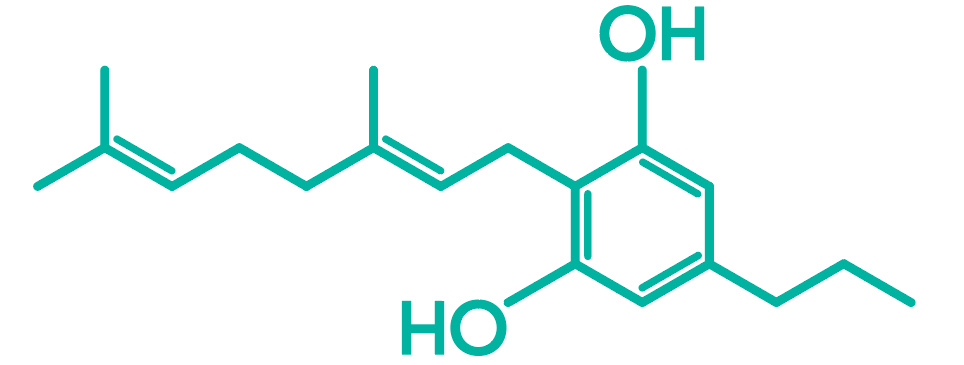


CBGV is a derivative of CBG. There aren’t as many known uses of CBGV as of yet. However, early research into this minor cannabinoid suggests that it may have therapeutic potential. Studies have shown that CBGV plays an important role in regulating gastrointestinal inflammation.(11)
This non-hallucinogenic cannabinoid could also be an important anti-cancer therapy. CBGV has been shown to arrest the growth of cultured cancerous leukemia cells at any phase of development.(12)
Beyond showing promise in treating these serious medical conditions, CBGV also appears to enhance the effects of CBD and other cannabinoids.(13) As more knowledge around CBGV develops, we’re excited to see CBGV be used as the main ingredient or a supplementary ingredient in various therapeutic formulations.
CBC (Cannabichromin)
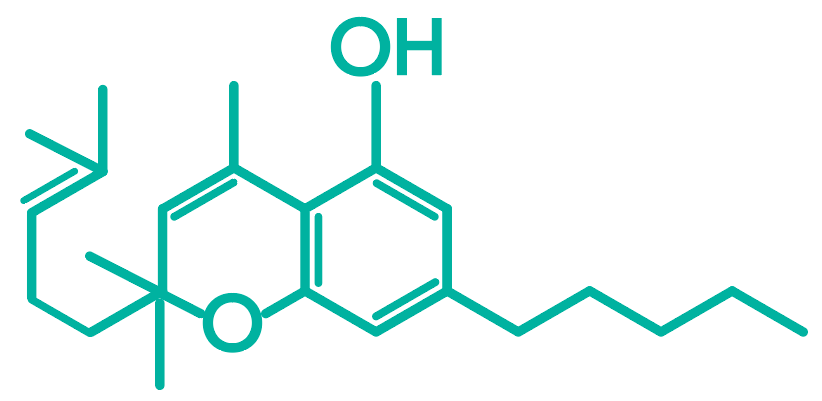


Current research suggests that CBC is among the most potent and multi-purpose cannabinoids in existence. The cannabinoid demonstrates serious medicinal use for a range of conditions. It also seems to have a high propensity for entourage effects, meaning that it can enhance the effects of other cannabinoids.
CBC is one of the most potent anticancer cannabinoids.(14) Beyond that, CBC has exhibited powerful antibacterial effects, moderate antifungal activity, and wide-ranging anti-inflammatory activities.(15)
These anti-inflammatory properties mean that CBC could find use in alleviating pain and inflammation, skin conditions like acne, and diseases like Alzheimer’s that are related to neural inflammation. CBC also appears to work in conjunction with CBD and THC to deliver antidepressant properties.(16)
Scientists believe that one of the reasons that CBC is so effective is that it works with various biological receptors, in addition to the endocannabinoid system (ECS). This means that CBC can have primary and secondary effects in the body, working as a phytocannabinoid and triggering the production of endocannabinoids.(17) As we learn more about exactly how and what CBC does, you can probably expect to start seeing all sorts of formulations.
CBCV (Cannabichromeravin)
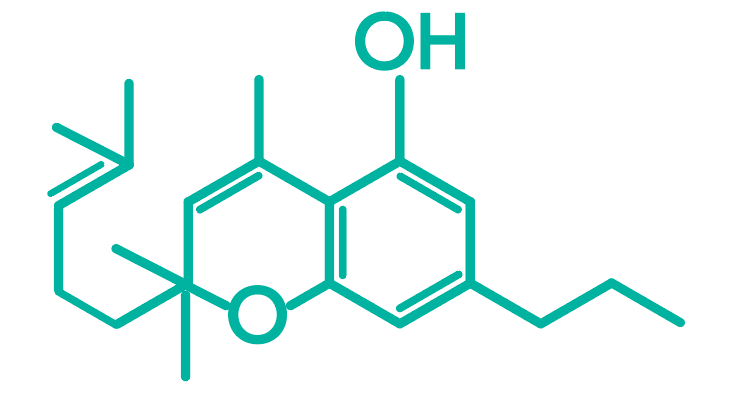


As the name suggests, CBCV is a derivative of the great and powerful CBC. Far less research has been done on CBCV, but some doctors suggest that it can be “helpful in coping with muscular dystrophy, eczema, epileptic seizures, and Crohn’s disease.”(18) CBCV has also been included in patents for anticonvulsant drugs.(19)
CBCV is an interesting cannabinoid because it’s immense medical potential has not yet triggered serious research. As testing continues, we expect to learn a lot more about CBCV.
CBDV (Cannabidivarin)
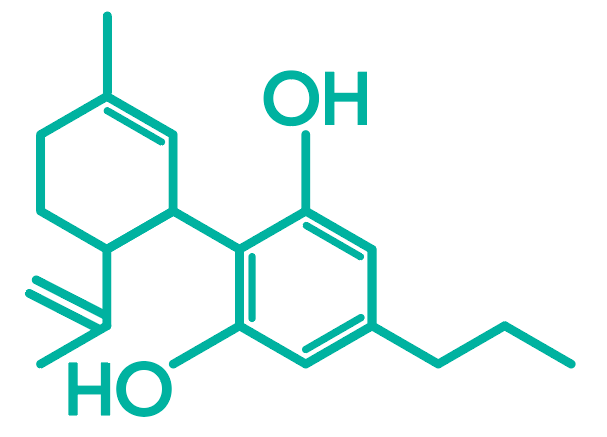


CBDV is a homolog of the well known CBD. It is almost identical to CBD, but with a chemical structure that is shortened by two methylene bridges. Like CBD, CBDV has many exciting potential medicinal properties.
Far from triggering intoxicating mental effects, CBDV has actually been found to reverse memory defect issues in animal studies.(20) CBDV is also being investigated as a treatment for childhood intractable epilepsy and autism spectrum disorder.(21)
Researchers like the potential of CBDV as a treatment for various stomach issues because the non-euphoric cannabinoid has a “favorable safety profile in humans” and shows promise in treatment of animal models of inflammatory bowel disease and in reducing inflammation of tissues in patients with ulcerative colitis.(22) CBDV may actually help out the entire digestive tract, as the cannabinoid may also reduce nausea.(23)
CBDV’s anti-inflammatory properties also make it a promising treatment option for diseases that cause chronic inflammation or the degeneration of skeletal muscle.(24)
When you add up all the benefits of CBDV it’s kind of surprising that its precursor CBD gets all the love. There isn’t anything wrong with CBD, it’s just that CBDV is incredibly powerful. We’re excited to see minor cannabinoids such as CBDV become more well-known and widely available.
THCV (Tetrahydrocannabivarin)
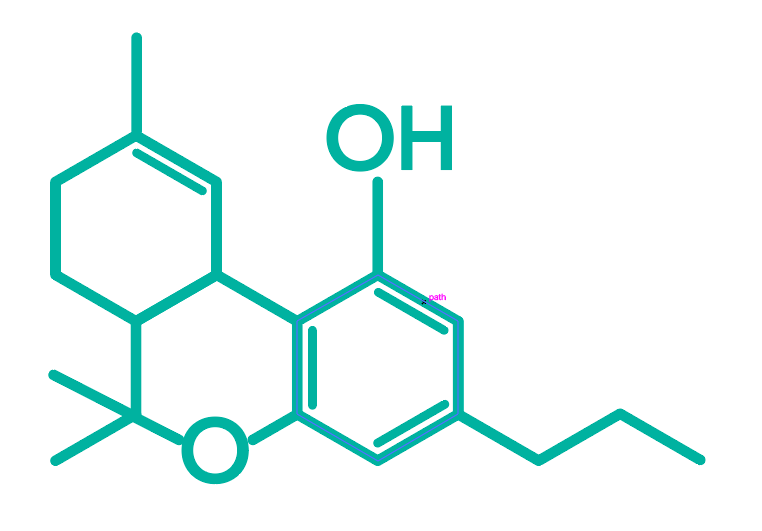


THCV is a derivative of THC, the psychoactive component of marijuana. And while THCV does have some psychoactive effects, they are noticeably different from those of THC.
For one, THCV is an appetite suppressant that can produce therapeutic metabolic effects. Far from giving you the munchies, THCV may actually help curb metabolic syndrome and type 2 diabetes.(25) And, instead of causing paranoia, THCV might stop panic attacks and reduce PTSD symptoms.(26)
If you need further convincing as to the benefits of THCV, you may also note that the cannabinoid has been found to relieve symptoms of Parkinson’s disease and nicotine dependence in animal studies. (27, 28)
Introduction of THCV into the community is potentially complicated by the fact that excessive dosing could produce transient high levels of the cannabinoid and result in a brief period of psychoactive response. Accordingly, efforts are now being directed at dosing and delivery formulations that avoid a spike in the levels of THCV and instead promise to deliver smooth and sustained non-psychotropic activity.
CBN (Cannabinol)
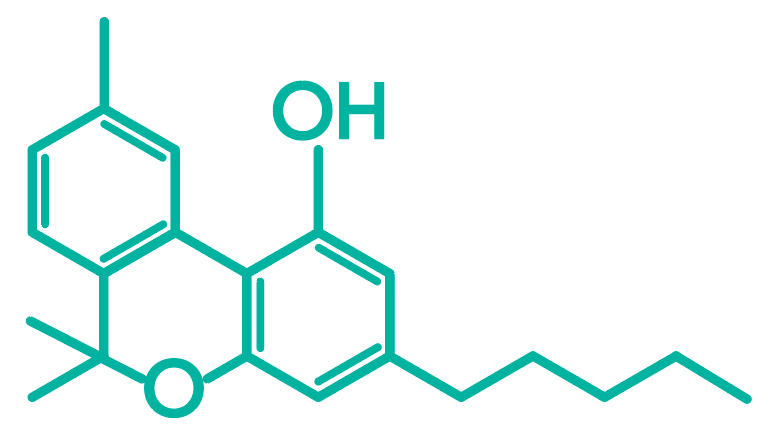


CBN is the final cannabinoid that we’ll discuss here. In some ways, it is the most unique of these seven cannabinoids because it is 4 steps removed from CBGA, and is the lone occupant on the bottom rung of our cannabinoid family tree.
Scientists tend to consider CBN either entirely non-psychoactive or mildly psychoactive.(29) This is because it does not cause a THC-like euphoric high, but rather a powerful state of relaxation or sedation.
CBN shares many of the properties that the aforementioned cannabinoids exhibit: It may be able to relieve pain, fight cancer, and combat bacteria. It may also be used as an anticonvulsant, a treatment for glaucoma, or a stimulant for the production of bone growth. This last property may be particularly interesting as a therapy for broken bones and osteoporosis.(30)
Curiously, CBN has some effects that are almost the exact opposite of THCV. Where THCV is an appetite suppressant, CBN is actually an appetite stimulant.(31) And, where THCV can increase energy, CBN tends to act as a sedative that may help manage sleep or anxiety disorders.(32) Like most cannabinoids, CBN appears to exhibit entourage effects and may produce an even more pronounced sedative effect when paired with other cannabinoids.(33)
Again, we’re still in the early phases of uncovering and understanding the effects of cannabinoids such as CBN. However, the range and potency of these cannabinoids is extremely exciting.
The Future of Cannabinology
There’s a lot to get excited about when it comes to the nascent field of cannabinology. We’ve already observed tons of unique benefits amongst the seven discussed cannabinoids, and we’re just starting to scratch the surface. We still have a lot to learn about each of these seven cannabinoids, and even more to discover about the dozens of other even more mysterious cannabinoids.
As of now, most consumers are only able to obtain CBD-based products. This isn’t really a problem, as CBD is an effective treatment for many conditions. However, if you’re interested in receiving benefits from minor cannabinoids, you may want to opt for whole spectrum CBD oils. Hemp plants naturally contain all of these minor cannabinoids, so the less processed your product of choice is, the more minor cannabinoids it will contain.
We can also look forward to designer combinations of different cannabinoids in the coming years. Future formulations may isolate these cannabinoids individually or may combine them in calculated ways. Multi-cannabinoid products may take advantage of entourage effects, and use combinations of specific cannabinoids to increase potency. Or, products may combine certain cannabinoids for highly specific reasons. For example, you may be able to combine THCV and CBD to create an anti-inflammatory supplement that neither stimulates nor decreases appetite.
We’ve learned a lot about cannabinoids during the last decade, and we’re now learning more every day. The future of cannabinology looks extremely bright, even if we don’t know exactly what will happen. There is more research to be done, new cannabinoids to discover, and exciting products to formulate.
Different cultures have been using hemp as medicine for millennia, unwittingly taking advantage of the many benefits of all the hemp-based cannabinoids. As we turn the rigorous eye of science towards specific cannabinoids, we may end up relearning what we already knew. And at this confluence of ancient wisdom and cutting-edge science, we may find some truly lasting cures.
References
1.National Center for Biotechnology Information. “Cannabinoids.” PubChem Database. ://pubchem.ncbi.nlm.nih.gov/compound/Cannabinoids.
2. Ibid
3. Ibid
4. Mechoulam R. “Plant cannabinoids: a neglected pharmacological treasure trove.” Br J Pharmacology 147, no. 7 (2005): 913-5. Web.
5. National Center for Biotechnology Information. “Cannabinoids.”
6. Gugliandolo, Agnese et al. “In Vitro Model of Neuroinflammation: Efficacy of Cannabigerol, a Non-Psychoactive Cannabinoid.” International journal of molecular sciences 19,7 no. 1992 (2018) Web.
7. Borrelli, Francesca et al. “Beneficial effect of the non-psychotropic plant cannabinoid cannabigerol on experimental inflammatory bowel disease.” Biochemical pharmacology 85, no. 9 (2013). Web.
8. Borrelli F, Pagano E, Romano B, et al. Colon carcinogenesis is inhibited by the TRPM8 antagonist cannabigerol, a Cannabis-derived non-psychotropic cannabinoid. Carcinogenesis. 12, no. 35 (2014): 2787‐97. Web.
9. Appendino, Giovanni et al. “Antibacterial cannabinoids from Cannabis sativa: a structure-activity study.” Journal of natural products 71, no. 8 (2008): 1427-30. Web.
10. Tóth, Kinga Fanni et al. “Cannabinoid Signaling in the Skin: Therapeutic Potential of the “Cannabinoid” System.” Molecules (Basel, Switzerland) 24, no.5 (2019). Web.
11. De Petrocellis L, Orlando P, Moriello AS, et al. Cannabinoid actions at TRPV channels: effects on TRPV3 and TRPV4 and their potential relevance to gastrointestinal inflammation. Acta Physiol 204, no. 2 (2012): 255‐66. Web.
12. University of St George’s London. “Non-hallucinogenic cannabinoids are effective anti-cancer drugs.” ScienceDaily. ScienceDaily, 14 (2013). Web.
13. De Petrocellis, Luciano et al. “Effects of cannabinoids and cannabinoid-enriched Cannabis extracts on TRP channels and endocannabinoid metabolic enzymes.” British journal of pharmacology 163, no. 7 (2011): 1479-94. Web.
14. Ligresti, Moriello et al. “Antitumor Activity of Plant Cannabinoids with Emphasis on the Effect of Cannabidiol on Human Breast Carcinoma.” Journal of Pharmacology and Experimental Therapeutics 318, no. 3 (2006): 1375-87. Web.
15. Turner, C. E., & Elsohly, M. A. “Biological activity of cannabichromene, its homologs and isomers.” Journal of clinical pharmacology 21, no. 1 (1981): 283-91. Web.
16. El-Alfy, Abir T et al. “Antidepressant-like effect of delta9-tetrahydrocannabinol and other cannabinoids isolated from Cannabis sativa L.” Pharmacology, biochemistry, and behavior 95, no. 4 (2010). Web.
17. Maione, Piscitelli, et al. “Non‐psychoactive cannabinoids modulate the descending pathway of antinociception in anaesthetized rats through several mechanisms of action.” British Journal of Pharmacology, 162: (2011): 584-96.
18. Andrea, “Overview of CBCv.” Last modified June, 2019. https://echoconnection.org/overview-of-cbcv/
19. Otsuka Pharmaceutical Co., Limited. 2012. “A Pharmaceutical Composition Comprising the Phytocannabinoids Cannabidivarin (CBDV) and Cannabinol (CBD).” United States of America.
https://patents.justia.com/patent/20140243405
20. Zamberletti, Gabaglio, Piscitelli et al. “Cannabidivarin completely rescues cognitive deficits and delays neurological and motor defects in male Mecp2 mutant mice.” J Psychopharmacol 33, no. 3 (2019): 894‐907. Web.
21. Pretzch, Voinescu et al. “Effects of cannabidivarin (CBDV) on brain excitation and inhibition systems in adults with and without Autism Spectrum Disorder (ASD): a single dose trial during magnetic resonance spectroscopy.” Translational Psychiatry 9, no. 31 (2019). Web.
22. Pagano, E et al. “The non-euphoric phytocannabinoid cannabidivarin counteracts intestinal inflammation in mice and cytokine expression in biopsies from UC pediatric patients.” Pharmacological research vol. 149 (2019). Web.
23. Rock, Erin M et al. “Evaluation of the potential of the phytocannabinoids, cannabidivarin (CBDV) and Δ(9) -tetrahydrocannabivarin (THCV), to produce CB1 receptor inverse agonism symptoms of nausea in rats.” British journal of pharmacology 170, no. 3 (2013): 671-8. Web
24. Iannotti, Fabio Arturo et al. “Effects of non-euphoric plant cannabinoids on muscle quality and performance of dystrophic mdx mice.” British journal of pharmacology 176, no. 10 (2019): 1568-84. Web.
25. Wargent, E T et al. “The cannabinoid Δ(9)-tetrahydrocannabivarin (THCV) ameliorates insulin sensitivity in two mouse models of obesity.” Nutrition & diabetes 3, no. 5 (2013): Web.
26. Campos, de Paula Soares, Carvalho et al. Involvement of serotonin-mediated neurotransmission in the dorsal periaqueductal gray matter on cannabidiol chronic effects in panic-like responses in rats. Psychopharmacology 226 (2013): 13–24. Web.
27. Garcia, Paloma-Garo et al. “Symptom‐relieving and neuroprotective effects of the phytocannabinoid Δ9‐THCV in animal models of Parkinson’s disease.” British Journal of Pharmacology 137, no. 7 (2011): Web.
28. Xi, Muldoon, Wang et al. “Δ8 -Tetrahydrocannabivarin has potent anti-nicotine effects in several rodent models of nicotine dependence.” Br J Pharmacol. 176, no. 24 (2019): 4773‐84. Web.
29. Breus, J Michael. “Research Shows 9 Potential Health Benefits of CBN.” Psychology Today. Last modified August, 2019. https://www.psychologytoday.com/us/blog/sleep-newzzz/201908/research-shows-9-potential-health-benefits-cbn
30.Ibid.
31. Brierley et al. “Cannabigerol is a novel, well-tolerated appetite stimulant in pre-satiated rats.” Psychopharmacology 233, no. 19-20 (2016): 3603-13. Web.
32. Breus, J Michael. “Research Shows 9 Potential Health Benefits of CBN.”
33. Takahashi and Karniol. “Pharmacologic interaction between cannabinol and delta9-tetrahydrocannabinol.” Psychopharmacologia 41, no. 3 (1975): 277-84. Web.
There are more than one hundred different cannabinoids in hemp. But, in recent years, CBD has attracted a disproportionate amount of attention. It’s true that the recognition and popularity of CBD is deserved, but this shouldn’t distract from the fact that there are dozens of other potentially even more interesting cannabinoids within the hemp plant. In this post, we’ll provide an overview of seven other extremely promising cannabinoids.
The Cannabinoid Family Tree



In order to understand how these different cannabinoids relate to each other, it’s helpful to understand the cannabinoid family tree. Cannabinoid synthesis begins with CBGA (Cannabigerolic Acid), so you can think of CBGA as the head of the family tree.(1)
After CBGA has been made, hemp plants can then naturally synthesize three more cannabinoids: CBDA (Cannabinolic Acid), THCA (Tetrahydrocannabinolic Acid), and CBCA (Cannabichromenic Acid). The ‘A’ suffix on each of these signifies that these are acids.(2)
The next generation of cannabinoids includes CBD, THC, and CBC. As these names suggest, these are simply the non-acidic versions of the predominant cannabinoid acids. CBD, for example, is almost structurally identical to CBDA. The only difference between these is that CBDA has an extra carboxyl group which makes it an acid, while CBD does not have this carboxyl group.(3)
Cannabinoids can be decarboxylated through heat or time. Decarboxylation is sometimes referred to as “activation” because scientists previously believed that cannabinoid acids were biologically inactive. However, recent studies have disproved this belief, and we now know that cannabinoid acids do have biological benefits. For this reason, we like to think of decarboxylation as “transformation” instead of “activation.” CBDA and CBD, for example, are both active compounds, they simply do different things.(4)
The final generation of cannabinoids includes CBGV (Cannabigeroverin), CBCV (Cannabichromeravin), CBDV (Cannabidivarin), and THCV (Tetrahydrocannabivarin). The ‘V’ ending on each of these cannabinoids signifies that they are chemically shortened. CBDV, for example, looks like a CBD molecule that is missing two methyl bridges. Biochemistry aside, the big thing to note about the ‘V’ class of cannabinoids is that while they are structurally similar to their precursors they also produce different biological effects.(5)
Understanding Cannabinoids
Every generation and vertical line of cannabinoids comes with a unique set of traits and biological effects. Because of this, different people will be most interested in different cannabinoids, or different combinations of cannabinoids. However, until recently consumers have been constrained by the biological variability of hemp plants.
Breakthroughs in cannabinoid science now allow cutting-edge producers to synthesize and isolate specific cannabinoids, including CBG, CBGV, CBC, CBCV, CBDV, THCV, and CBN. In the wild, hemp plants will naturally contain less than 1% of these minor cannabinoids. However, only a few of today’s top labs have pioneered how to isolate these cannabinoids. With these cannabinoids now available, it is time for us to consider the benefits of each. Here’s what we know about each of these cannabinoids:
CBG (Cannabigerol)



CBG is a non-psychotropic cannabinoid that shows promise in treating many different medical conditions. A 2018 study found that CBG exerted a protective action in an in vitro neuroinflammation model. This means that CBG may reduce oxidation and inflammation in brain cells. The scientists behind this study now “encourage the use of CBG against neurodegeneration and in those pathological conditions where neuroinflammation and oxidative stress play a main role.” More research is needed, but the idea that CBG may treat neurodegenerative conditions such as Alzheimer’s, Parkinson’s, and Huntington’s Disease is encouraging.(6)
In animal studies, therapy with CBG has also been found to reduce signs of colitis in a classic model mimicking ulcerative colitis and crohn’s disease. It appeared from this study that CBG works by reducing the production of inflammatory signals as well as curtailing the generation of toxic free radicals.(7)
Whereas many cannabinoids show promise as anti-cancer remedies, CBG was found to be the most effective cannabinoid at inhibiting the growth of new cancer cells. In fact, administration of CBD to a mouse model of human tumor colon cells impressively diminished tumor growth and was well tolerated, suggesting its potential utility in the therapy of human cancer.(8)
CBG is also one of the many cannabinoids with antibacterial properties; CBD, CBC, THC, CBG, and CBN all demonstrate “potent activity against a variety of methicillin-resistant Staphylococcus aureus (MRSA) strains of current clinical relevance.”(9)
Finally, CBG has shown a lot of promise as a treatment for skin conditions, in particular those associated with a lack of hydration. Accordingly, this multi-capable cannabinoid may be particularly effective for treating those conditions in which skin dryness is prominent – psoriasis, and eczema.(10)
CBGV (Cannabigerovarin)



CBGV is a derivative of CBG. There aren’t as many known uses of CBGV as of yet. However, early research into this minor cannabinoid suggests that it may have therapeutic potential. Studies have shown that CBGV plays an important role in regulating gastrointestinal inflammation.(11)
This non-hallucinogenic cannabinoid could also be an important anti-cancer therapy. CBGV has been shown to arrest the growth of cultured cancerous leukemia cells at any phase of development.(12)
Beyond showing promise in treating these serious medical conditions, CBGV also appears to enhance the effects of CBD and other cannabinoids.(13) As more knowledge around CBGV develops, we’re excited to see CBGV be used as the main ingredient or a supplementary ingredient in various therapeutic formulations.
CBC (Cannabichromin)



Current research suggests that CBC is among the most potent and multi-purpose cannabinoids in existence. The cannabinoid demonstrates serious medicinal use for a range of conditions. It also seems to have a high propensity for entourage effects, meaning that it can enhance the effects of other cannabinoids.
CBC is one of the most potent anticancer cannabinoids.(14) Beyond that, CBC has exhibited powerful antibacterial effects, moderate antifungal activity, and wide-ranging anti-inflammatory activities.(15)
These anti-inflammatory properties mean that CBC could find use in alleviating pain and inflammation, skin conditions like acne, and diseases like Alzheimer’s that are related to neural inflammation. CBC also appears to work in conjunction with CBD and THC to deliver antidepressant properties.(16)
Scientists believe that one of the reasons that CBC is so effective is that it works with various biological receptors, in addition to the endocannabinoid system (ECS). This means that CBC can have primary and secondary effects in the body, working as a phytocannabinoid and triggering the production of endocannabinoids.(17) As we learn more about exactly how and what CBC does, you can probably expect to start seeing all sorts of formulations.
CBCV (Cannabichromeravin)



As the name suggests, CBCV is a derivative of the great and powerful CBC. Far less research has been done on CBCV, but some doctors suggest that it can be “helpful in coping with muscular dystrophy, eczema, epileptic seizures, and Crohn’s disease.”(18) CBCV has also been included in patents for anticonvulsant drugs.(19)
CBCV is an interesting cannabinoid because it’s immense medical potential has not yet triggered serious research. As testing continues, we expect to learn a lot more about CBCV.
CBDV (Cannabidivarin)



CBDV is a homolog of the well known CBD. It is almost identical to CBD, but with a chemical structure that is shortened by two methylene bridges. Like CBD, CBDV has many exciting potential medicinal properties.
Far from triggering intoxicating mental effects, CBDV has actually been found to reverse memory defect issues in animal studies.(20) CBDV is also being investigated as a treatment for childhood intractable epilepsy and autism spectrum disorder.(21)
Researchers like the potential of CBDV as a treatment for various stomach issues because the non-euphoric cannabinoid has a “favorable safety profile in humans” and shows promise in treatment of animal models of inflammatory bowel disease and in reducing inflammation of tissues in patients with ulcerative colitis.(22) CBDV may actually help out the entire digestive tract, as the cannabinoid may also reduce nausea.(23)
CBDV’s anti-inflammatory properties also make it a promising treatment option for diseases that cause chronic inflammation or the degeneration of skeletal muscle.(24)
When you add up all the benefits of CBDV it’s kind of surprising that its precursor CBD gets all the love. There isn’t anything wrong with CBD, it’s just that CBDV is incredibly powerful. We’re excited to see minor cannabinoids such as CBDV become more well-known and widely available.
THCV (Tetrahydrocannabivarin)



THCV is a derivative of THC, the psychoactive component of marijuana. And while THCV does have some psychoactive effects, they are noticeably different from those of THC.
For one, THCV is an appetite suppressant that can produce therapeutic metabolic effects. Far from giving you the munchies, THCV may actually help curb metabolic syndrome and type 2 diabetes.(25) And, instead of causing paranoia, THCV might stop panic attacks and reduce PTSD symptoms.(26)
If you need further convincing as to the benefits of THCV, you may also note that the cannabinoid has been found to relieve symptoms of Parkinson’s disease and nicotine dependence in animal studies. (27, 28)
Introduction of THCV into the community is potentially complicated by the fact that excessive dosing could produce transient high levels of the cannabinoid and result in a brief period of psychoactive response. Accordingly, efforts are now being directed at dosing and delivery formulations that avoid a spike in the levels of THCV and instead promise to deliver smooth and sustained non-psychotropic activity.
CBN (Cannabinol)



CBN is the final cannabinoid that we’ll discuss here. In some ways, it is the most unique of these seven cannabinoids because it is 4 steps removed from CBGA, and is the lone occupant on the bottom rung of our cannabinoid family tree.
Scientists tend to consider CBN either entirely non-psychoactive or mildly psychoactive.(29) This is because it does not cause a THC-like euphoric high, but rather a powerful state of relaxation or sedation.
CBN shares many of the properties that the aforementioned cannabinoids exhibit: It may be able to relieve pain, fight cancer, and combat bacteria. It may also be used as an anticonvulsant, a treatment for glaucoma, or a stimulant for the production of bone growth. This last property may be particularly interesting as a therapy for broken bones and osteoporosis.(30)
Curiously, CBN has some effects that are almost the exact opposite of THCV. Where THCV is an appetite suppressant, CBN is actually an appetite stimulant.(31) And, where THCV can increase energy, CBN tends to act as a sedative that may help manage sleep or anxiety disorders.(32) Like most cannabinoids, CBN appears to exhibit entourage effects and may produce an even more pronounced sedative effect when paired with other cannabinoids.(33)
Again, we’re still in the early phases of uncovering and understanding the effects of cannabinoids such as CBN. However, the range and potency of these cannabinoids is extremely exciting.
The Future of Cannabinology
There’s a lot to get excited about when it comes to the nascent field of cannabinology. We’ve already observed tons of unique benefits amongst the seven discussed cannabinoids, and we’re just starting to scratch the surface. We still have a lot to learn about each of these seven cannabinoids, and even more to discover about the dozens of other even more mysterious cannabinoids.
As of now, most consumers are only able to obtain CBD-based products. This isn’t really a problem, as CBD is an effective treatment for many conditions. However, if you’re interested in receiving benefits from minor cannabinoids, you may want to opt for whole spectrum CBD oils. Hemp plants naturally contain all of these minor cannabinoids, so the less processed your product of choice is, the more minor cannabinoids it will contain.
We can also look forward to designer combinations of different cannabinoids in the coming years. Future formulations may isolate these cannabinoids individually or may combine them in calculated ways. Multi-cannabinoid products may take advantage of entourage effects, and use combinations of specific cannabinoids to increase potency. Or, products may combine certain cannabinoids for highly specific reasons. For example, you may be able to combine THCV and CBD to create an anti-inflammatory supplement that neither stimulates nor decreases appetite.
We’ve learned a lot about cannabinoids during the last decade, and we’re now learning more every day. The future of cannabinology looks extremely bright, even if we don’t know exactly what will happen. There is more research to be done, new cannabinoids to discover, and exciting products to formulate.
Different cultures have been using hemp as medicine for millennia, unwittingly taking advantage of the many benefits of all the hemp-based cannabinoids. As we turn the rigorous eye of science towards specific cannabinoids, we may end up relearning what we already knew. And at this confluence of ancient wisdom and cutting-edge science, we may find some truly lasting cures.
References
1.National Center for Biotechnology Information. “Cannabinoids.” PubChem Database. ://pubchem.ncbi.nlm.nih.gov/compound/Cannabinoids.
2. Ibid
3. Ibid
4. Mechoulam R. “Plant cannabinoids: a neglected pharmacological treasure trove.” Br J Pharmacology 147, no. 7 (2005): 913-5. Web.
5. National Center for Biotechnology Information. “Cannabinoids.”
6. Gugliandolo, Agnese et al. “In Vitro Model of Neuroinflammation: Efficacy of Cannabigerol, a Non-Psychoactive Cannabinoid.” International journal of molecular sciences 19,7 no. 1992 (2018) Web.
7. Borrelli, Francesca et al. “Beneficial effect of the non-psychotropic plant cannabinoid cannabigerol on experimental inflammatory bowel disease.” Biochemical pharmacology 85, no. 9 (2013). Web.
8. Borrelli F, Pagano E, Romano B, et al. Colon carcinogenesis is inhibited by the TRPM8 antagonist cannabigerol, a Cannabis-derived non-psychotropic cannabinoid. Carcinogenesis. 12, no. 35 (2014): 2787‐97. Web.
9. Appendino, Giovanni et al. “Antibacterial cannabinoids from Cannabis sativa: a structure-activity study.” Journal of natural products 71, no. 8 (2008): 1427-30. Web.
10. Tóth, Kinga Fanni et al. “Cannabinoid Signaling in the Skin: Therapeutic Potential of the “Cannabinoid” System.” Molecules (Basel, Switzerland) 24, no.5 (2019). Web.
11. De Petrocellis L, Orlando P, Moriello AS, et al. Cannabinoid actions at TRPV channels: effects on TRPV3 and TRPV4 and their potential relevance to gastrointestinal inflammation. Acta Physiol 204, no. 2 (2012): 255‐66. Web.
12. University of St George’s London. “Non-hallucinogenic cannabinoids are effective anti-cancer drugs.” ScienceDaily. ScienceDaily, 14 (2013). Web.
13. De Petrocellis, Luciano et al. “Effects of cannabinoids and cannabinoid-enriched Cannabis extracts on TRP channels and endocannabinoid metabolic enzymes.” British journal of pharmacology 163, no. 7 (2011): 1479-94. Web.
14. Ligresti, Moriello et al. “Antitumor Activity of Plant Cannabinoids with Emphasis on the Effect of Cannabidiol on Human Breast Carcinoma.” Journal of Pharmacology and Experimental Therapeutics 318, no. 3 (2006): 1375-87. Web.
15. Turner, C. E., & Elsohly, M. A. “Biological activity of cannabichromene, its homologs and isomers.” Journal of clinical pharmacology 21, no. 1 (1981): 283-91. Web.
16. El-Alfy, Abir T et al. “Antidepressant-like effect of delta9-tetrahydrocannabinol and other cannabinoids isolated from Cannabis sativa L.” Pharmacology, biochemistry, and behavior 95, no. 4 (2010). Web.
17. Maione, Piscitelli, et al. “Non‐psychoactive cannabinoids modulate the descending pathway of antinociception in anaesthetized rats through several mechanisms of action.” British Journal of Pharmacology, 162: (2011): 584-96.
18. Andrea, “Overview of CBCv.” Last modified June, 2019. https://echoconnection.org/overview-of-cbcv/
19. Otsuka Pharmaceutical Co., Limited. 2012. “A Pharmaceutical Composition Comprising the Phytocannabinoids Cannabidivarin (CBDV) and Cannabinol (CBD).” United States of America.
https://patents.justia.com/patent/20140243405
20. Zamberletti, Gabaglio, Piscitelli et al. “Cannabidivarin completely rescues cognitive deficits and delays neurological and motor defects in male Mecp2 mutant mice.” J Psychopharmacol 33, no. 3 (2019): 894‐907. Web.
21. Pretzch, Voinescu et al. “Effects of cannabidivarin (CBDV) on brain excitation and inhibition systems in adults with and without Autism Spectrum Disorder (ASD): a single dose trial during magnetic resonance spectroscopy.” Translational Psychiatry 9, no. 31 (2019). Web.
22. Pagano, E et al. “The non-euphoric phytocannabinoid cannabidivarin counteracts intestinal inflammation in mice and cytokine expression in biopsies from UC pediatric patients.” Pharmacological research vol. 149 (2019). Web.
23. Rock, Erin M et al. “Evaluation of the potential of the phytocannabinoids, cannabidivarin (CBDV) and Δ(9) -tetrahydrocannabivarin (THCV), to produce CB1 receptor inverse agonism symptoms of nausea in rats.” British journal of pharmacology 170, no. 3 (2013): 671-8. Web
24. Iannotti, Fabio Arturo et al. “Effects of non-euphoric plant cannabinoids on muscle quality and performance of dystrophic mdx mice.” British journal of pharmacology 176, no. 10 (2019): 1568-84. Web.
25. Wargent, E T et al. “The cannabinoid Δ(9)-tetrahydrocannabivarin (THCV) ameliorates insulin sensitivity in two mouse models of obesity.” Nutrition & diabetes 3, no. 5 (2013): Web.
26. Campos, de Paula Soares, Carvalho et al. Involvement of serotonin-mediated neurotransmission in the dorsal periaqueductal gray matter on cannabidiol chronic effects in panic-like responses in rats. Psychopharmacology 226 (2013): 13–24. Web.
27. Garcia, Paloma-Garo et al. “Symptom‐relieving and neuroprotective effects of the phytocannabinoid Δ9‐THCV in animal models of Parkinson’s disease.” British Journal of Pharmacology 137, no. 7 (2011): Web.
28. Xi, Muldoon, Wang et al. “Δ8 -Tetrahydrocannabivarin has potent anti-nicotine effects in several rodent models of nicotine dependence.” Br J Pharmacol. 176, no. 24 (2019): 4773‐84. Web.
29. Breus, J Michael. “Research Shows 9 Potential Health Benefits of CBN.” Psychology Today. Last modified August, 2019. https://www.psychologytoday.com/us/blog/sleep-newzzz/201908/research-shows-9-potential-health-benefits-cbn
30.Ibid.
31. Brierley et al. “Cannabigerol is a novel, well-tolerated appetite stimulant in pre-satiated rats.” Psychopharmacology 233, no. 19-20 (2016): 3603-13. Web.
32. Breus, J Michael. “Research Shows 9 Potential Health Benefits of CBN.”
33. Takahashi and Karniol. “Pharmacologic interaction between cannabinol and delta9-tetrahydrocannabinol.” Psychopharmacologia 41, no. 3 (1975): 277-84. Web.

